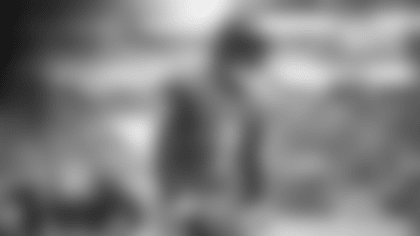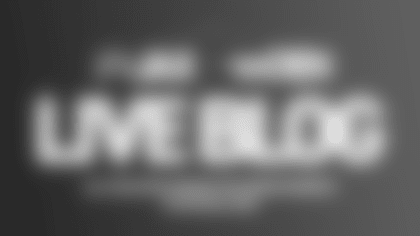Join jaguars.com senior editor Vic Ketchman as he tackles the fans' tough questions.
Jordan from Jacksonville:
If an excessive celebration penalty is called on a touchdown that ends up being reversed on a challenge, is the penalty assessed from the previous spot?
Vic: The penalty is assessed from where the ball is spotted following the replay-review decision. All personal fouls are assessed. There are situations when a penalty is extinguished on a replay-review reversal, but not if it's a personal foul.
Mike from Jacksonville:
I noticed that each quarterback has his own (language) at the line of scrimmage. For example, Byron says "blue 80" and Favre says "blue 56." I was wondering if you knew what it means?
Vic: Every team has a hot color, which is the color that alerts the offense that the quarterback is changing the play. When the quarterback calls out the hot color, usually the number that follows is the play to which he is switching. If the hot color is blue and it's followed by 80, then the offense is going to run its 80 play. "Blue 80," however, could be a dummy call; it could mean nothing. In Super Bowl XIV, Terry Bradshaw was playing against a Rams team that had several ex-Steelers coaches on it and they had the Steelers' whole audible system. Bradshaw tested it early in the game by calling "brown" and then a number. "Brown" was the Steelers' hot color and when Bradshaw called out the number, he watched the Rams linebackers jump down into the hole. That was the end of that. Bradshaw went multiple numbers the rest of the game. In the huddle he would call a play then say, "Check with me, second number on two." The "check with me" alerted his offense to a possible audible. "Second number" would be the play and "on two" was the snap count. Bradshaw also built in a lot of dummy calls to confuse the Rams defense. It was a masterful piece of quarterbacking and huddle leadership in the most pressure-packed of circumstances, especially for a quarterback who was calling his own plays. Dumb? Yeah, all the way to the bank.
Bill from Chappaqua, NY:
Recent events lead me to believe the Carolina Panthers have the best cheerleaders in the league. What is your opinion?
Vic: Eagles, then their mothers.
Thom from Jacksonville:
Many Colts and Jax fans think Henderson should have been evicted. Do you?
Vic: Eviction is a little harsh, don't you think? I mean, the guy's gotta live somewhere. It's almost Christmas and the weather's starting to get cold. Have a heart.
Nate from Tampa, FL:
What qualities, if any, do you see Greg Jones possessing that remind you of James Stewart?
Vic: They're completely different guys. James Stewart was a true feature running back who was faster and more athletic. Stewart was one of the best goal-line leapers I've ever seen. Stewart was a power runner but he didn't have Greg Jones' extreme power. Stewart didn't run through tacklers as Jones does. Jones is a pure pounder. There is no other way to describe his running style. If he's given a chance to get to the line of scrimmage, he gets yards. Penetration is the key to stopping Jones. If you can get to him before he gets a head of steam, his feet have a tendency to get in the way. Once he gets rolling, you're in the way. That's not how I would describe Stewart.
Greg from Matthews, NC:
Since your Tuesday column invited questions concerning rules, I'm hoping you'll help me understand why the officiating crew maintains an orange marker (almost identical to the first down markers) at the original line of scrimmage for every drive regardless of how far down the field a team travels.
Vic: You're talking about the drive-start marker. It's only purpose is to mark the spot at which the drive began. It helps the press box stats crew do its job.
Jeremy from Jacksonville:
What do you make of the Texans hiring Dan Reeves as a consultant to evaluate the team?
Vic: My guess is it's the first of several changes to come.
Cory from Jacksonville:
Do you think there are any teams throwing games for a number one pick? The Texans are looking like they are.
Vic: I refuse to believe that. I won't allow myself to believe that. I understand, however, how that horrible chip-shot miss by Kris Brown would raise suspicion. It was the ugliest moment of a terribly ugly season for the Texans.
Brian from Durham, NC:
This concerns Mike Vick on MNF where he jumped toward the end zone but out of bounds from about the two-yard line. While in the air, he had the ball in his left hand (past the goal line but to the left of the field of play) but passed his right hand above the pylon (didn't touch the pylon, just passed over it). The result of the play was a touchdown. Is this truly a legal touchdown?
Vic: What you're describing is the old "around the world" rule; that the goal line extends around the world. It allowed for a player to jump out of bounds at the one, for example, land out of bounds beyond the goal line without the ball crossing the goal line inbounds, and have been ruled to have scored a touchdown. In other words, the player would've advanced the ball across the "infinite plane" of the goal line without having contacted an area out of bounds. You can't, however, find that definition in the rule book today. If you look in the current rule book, this is the definition of a touchdown: "The situation in which any part of the ball, legally in possession of a player inbounds, is on, above or behind the opponent's goal line, provided it's not a touchback." There is no mention of the "infinite plane." We had this debate on "Jaguars This Week" a couple of months ago and I did extensive research on it. I was told that the league was not using the old "around the world" interpretation because Mike Pereira, the NFL's director of officiating, didn't want it called that way. I was told Pereira wants the ball to have crossed above or inside the pylon for the play to be ruled a touchdown. Well, apparently, the "around the world" rule was applied on Monday night. I can't tell you anything more. Maybe Pereira will offer an explanation.
Mike from Burbank, CA:
Could you please explain the "cover two" and the "3-3-5" defenses you mentioned in an answer?
Vic: Both are defenses geared primarily to stop the pass. "Cover two" is a base defense, whereas the "3-3-5" is more of a specialty defense. "Cover two" uses two cornerbacks up toward the line of scrimmage and two deep safeties in the middle of the field. In "cover two," the safeties are to stay deep and take away the deep pass; the cornerbacks are used as extra men in run-support. The idea of the "cover two" is to discourage quarterbacks from throwing deep. "Cover two" teams don't give up big plays. They do, however, have trouble stopping the run because they don't get that eighth man in the box. The addition of Corey Simon and the Colts' improvement up front this year have allowed them to play "cover two" and still stop the run. Tony Dungy was able to play "cover two" in Tampa and still stop the run because he had Warren Sapp in the middle. The "3-3-5" is nothing more than an "odd nickel." Usually, you would take out a linebacker and add a defensive back in "nickel," which would give you a 4-2-5 look. The "3-3-5" takes out a lineman and adds a defensive back. The Jaguars can do that because Marcus Stroud and John Henderson are so good. The Jaguars couldn't use their "3-3-5" against the Colts this past Sunday, however, because the Colts opened up with two tight ends. That would've given the Colts seven blockers against six guys up front, three of whom would've been linebackers, and that would've created a major mismatch in the running game.













